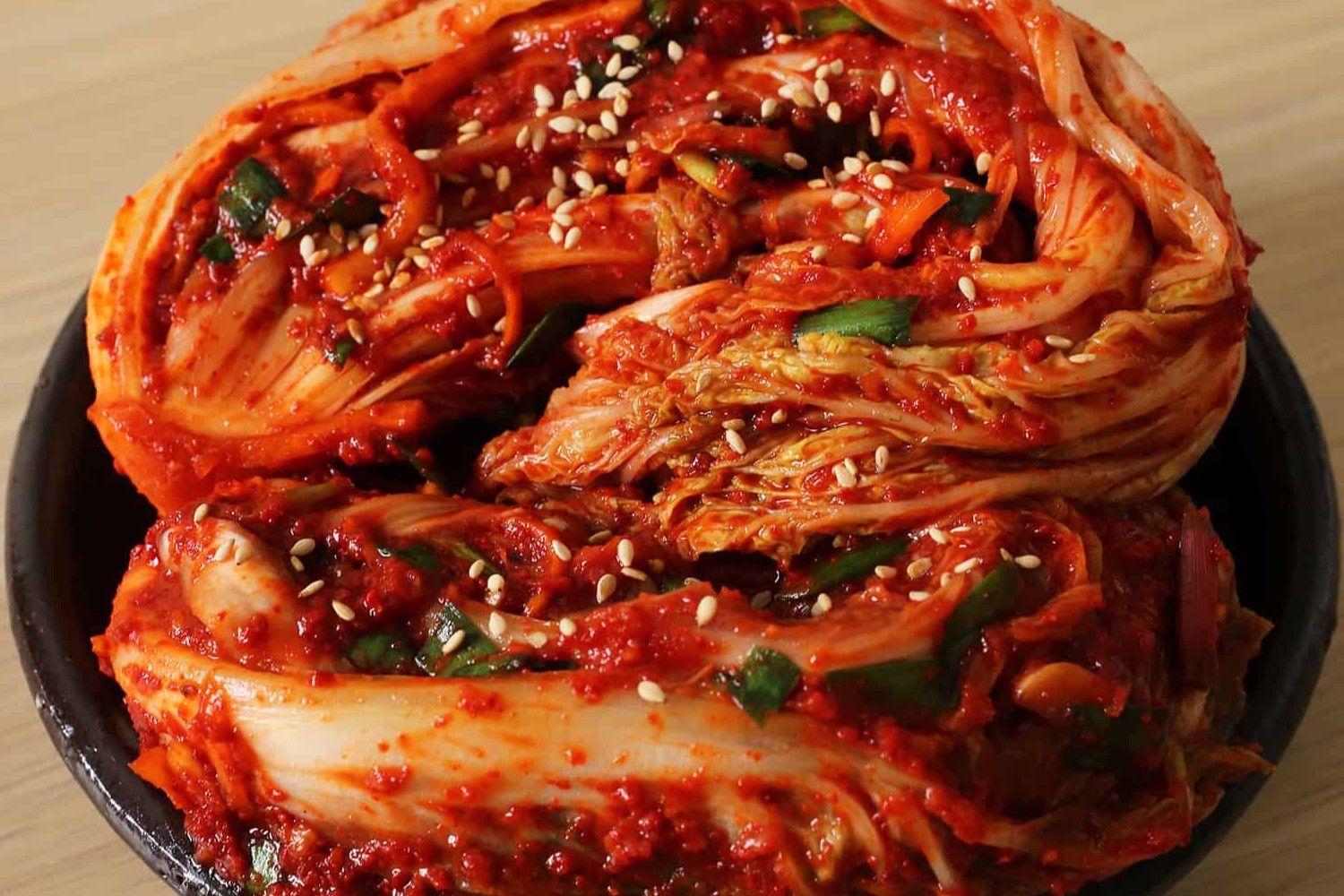This spicy cabbage kimchi recipe brings the authentic flavors of Korea right into your kitchen. With its bold, tangy, and spicy profile, this kimchi is perfect for adding a punch to any meal. Whether you're a seasoned kimchi lover or a newcomer, this recipe is sure to delight your taste buds.
Some ingredients in this recipe might not be commonly found in every household. Gochugaru is a Korean red pepper flake that gives kimchi its signature heat and color. Fish sauce adds a deep umami flavor, and while it might not be a pantry staple for everyone, it is essential for authentic kimchi. These items can usually be found in the international aisle of most supermarkets or at an Asian grocery store.

Ingredients For Spicy Cabbage Kimchi Recipe
Napa cabbage: A type of Chinese cabbage that is tender and perfect for kimchi.
Salt: Used for salting the cabbage to draw out moisture and begin the fermentation process.
Gochugaru: Korean red pepper flakes that provide the heat and color for the kimchi.
Garlic: Adds a pungent and aromatic flavor to the kimchi paste.
Ginger: Provides a warm, spicy undertone to the kimchi.
Fish sauce: Adds umami depth and a savory note to the kimchi.
Green onions: Contributes a fresh, mild onion flavor.
Carrot: Adds a slight sweetness and crunch to the kimchi.
Technique Tip for Making Kimchi
When preparing napa cabbage for kimchi, it's crucial to ensure that the cabbage is properly salted. This step not only draws out excess moisture but also helps to soften the cabbage, allowing it to absorb the flavors of the spicy paste. Make sure to rinse the cabbage thoroughly after salting to remove any excess salt, as this can affect the final taste of your kimchi. Additionally, when mixing the gochugaru paste with the cabbage, wearing gloves is essential to protect your hands from the spicy ingredients and to ensure even coating. Finally, when packing the kimchi into a jar, press down firmly to remove any air bubbles, which can interfere with the fermentation process.
Suggested Side Dishes
Alternative Ingredients
napa cabbage - Substitute with green cabbage: Green cabbage has a similar texture and can be used in place of napa cabbage for a slightly different but still delicious kimchi.
salt - Substitute with sea salt: Sea salt can be used for salting the cabbage as it provides a similar brine and flavor.
korean red pepper flakes (gochugaru) - Substitute with crushed red pepper flakes: Crushed red pepper flakes can be used, though they are spicier and less smoky than gochugaru. Adjust the amount to taste.
garlic - Substitute with garlic powder: Garlic powder can be used if fresh garlic is not available, though it will lack the same pungency and texture.
ginger - Substitute with ground ginger: Ground ginger can be used in place of fresh ginger, but use it sparingly as it is more concentrated.
fish sauce - Substitute with soy sauce: Soy sauce can be used as a vegetarian alternative to fish sauce, though it will change the flavor profile slightly.
green onions - Substitute with chives: Chives can be used in place of green onions for a similar mild onion flavor.
carrot - Substitute with daikon radish: Daikon radish can be used instead of carrot for a similar crunch and a slightly different flavor.
Alternative Recipes Similar to This Kimchi
How to Store or Freeze Your Kimchi
- Ensure your kimchi is packed tightly in an airtight container, leaving some space at the top for expansion. This prevents any unwanted air from spoiling your fermented delight.
- Store the container in the refrigerator once the fermentation process is complete. The cool temperature slows down the fermentation, allowing the kimchi to develop its flavors over time.
- For optimal taste, consume your kimchi within 3-4 weeks. However, it can last for several months in the refrigerator, becoming more pungent and sour as it ages.
- If you prefer to freeze your kimchi, portion it into smaller, freezer-safe containers or bags. This makes it easier to thaw only what you need.
- When freezing, ensure the containers are airtight to prevent freezer burn and maintain the kimchi's vibrant flavors.
- Label each container with the date of freezing to keep track of its freshness.
- To thaw, transfer the desired portion from the freezer to the refrigerator and let it thaw slowly overnight. This gradual thawing helps preserve the texture and taste.
- Avoid refreezing kimchi once it has been thawed, as this can compromise its quality and flavor.
- For a quick thaw, place the frozen kimchi in a bowl of cold water, changing the water every 30 minutes until fully thawed. This method is faster but may slightly alter the texture.
- Enjoy your spicy cabbage kimchi as a side dish, in soups, or as a flavorful addition to your favorite recipes.
How to Reheat Leftovers
Stovetop Method:
- Heat a skillet over medium heat.
- Add a small amount of vegetable oil or sesame oil to the pan.
- Add the kimchi and stir-fry for 3-5 minutes until heated through. This method enhances the flavors and adds a slight caramelization.
Microwave Method:
- Place the kimchi in a microwave-safe dish.
- Cover with a microwave-safe lid or plastic wrap, leaving a small vent.
- Heat on high for 1-2 minutes, stirring halfway through to ensure even heating.
Oven Method:
- Preheat your oven to 350°F (175°C).
- Spread the kimchi evenly on a baking sheet.
- Bake for 10-15 minutes until heated through. This method is great for larger quantities and adds a slight roasted flavor.
Steaming Method:
- Place the kimchi in a heatproof dish.
- Set up a steamer and bring water to a boil.
- Steam the kimchi for 5-7 minutes until thoroughly heated. This method retains the moisture and original texture.
Soup Method:
- Add the kimchi to a pot of broth or soup.
- Simmer for 5-10 minutes until the kimchi is heated through and the flavors meld together. This method is perfect for creating a comforting kimchi soup or stew.
Grill Method:
- Preheat your grill to medium-high heat.
- Place the kimchi on a piece of aluminum foil.
- Grill for 5-7 minutes, turning occasionally, until heated through and slightly charred. This method adds a smoky flavor to the kimchi.
Best Tools for Making Kimchi
Knife: For cutting the cabbage into quarters and removing the core.
Cutting board: To provide a stable surface for chopping the cabbage and other ingredients.
Large bowl: For salting the cabbage and tossing it to combine.
Colander: To rinse the cabbage under cold water and drain it well.
Mixing bowl: To combine the gochugaru, garlic, ginger, fish sauce, green onions, and carrot to form a paste.
Gloves: To protect your hands while mixing the spicy paste with the cabbage.
Jar: For packing the kimchi tightly and allowing it to ferment.
Spoon: To help mix the ingredients and pack the kimchi into the jar.
Measuring cups: To measure out the salt, gochugaru, and fish sauce accurately.
Grater: For grating the ginger.
How to Save Time on Making Kimchi
Pre-salt the cabbage: Salt the napa cabbage the night before to save time on the day of preparation.
Use a food processor: Mince garlic and grate ginger quickly using a food processor.
Pre-mix the paste: Prepare the gochugaru paste in advance and store it in the fridge.
Batch preparation: Double the recipe and make a larger batch to save time on future meals.
Pre-chop vegetables: Chop the green onions and carrot ahead of time and store them in airtight containers.
Spicy Cabbage Kimchi Recipe
Ingredients
Main Ingredients
- 1 large Napa cabbage cut into quarters
- ¼ cup Salt for salting the cabbage
- 1 cup Korean red pepper flakes (gochugaru)
- 5 cloves Garlic minced
- 1 tablespoon Ginger grated
- 2 tablespoon Fish sauce
- 1 bunch Green onions chopped
- 1 medium Carrot julienned
Instructions
- 1. Cut the cabbage into quarters and remove the core. Cut each quarter into 2-inch wide strips.
- 2. Place the cabbage in a large bowl and sprinkle with salt. Toss to combine and let sit for 1-2 hours, tossing occasionally.
- 3. Rinse the cabbage under cold water to remove excess salt. Drain well and set aside.
- 4. In a separate bowl, combine the gochugaru, garlic, ginger, fish sauce, green onions, and carrot. Mix well to form a paste.
- 5. Wearing gloves, add the paste to the cabbage and mix thoroughly, ensuring all the cabbage pieces are coated.
- 6. Pack the kimchi tightly into a jar, pressing down to remove air bubbles. Leave some space at the top for expansion.
- 7. Let the jar sit at room temperature for 1-2 days to ferment. Once fermented, store in the refrigerator.
Nutritional Value
Keywords
More Amazing Recipes to Try 🙂
- Birria Quesa Tacos Recipe3 Hours 30 Minutes
- Peruvian Chicha Morada Drink Recipe55 Minutes
- Linguine with Clam Sauce Recipe35 Minutes
- Sausage Stuffed Jalapenos Recipe35 Minutes
- Cowboy Caviar Recipe15 Minutes
- Ground Beef and Potatoes Recipe40 Minutes
- Turkey Avocado Panini Recipe15 Minutes
- Chicken Wing Dip Recipe30 Minutes

Leave a Reply